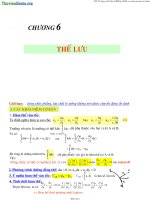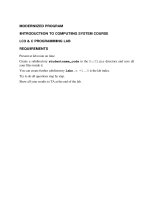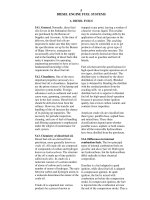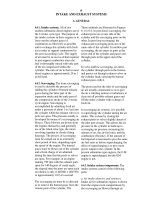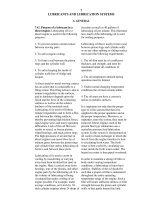Tài liệu Mechanical Engineers'''' Handbook pdf
Bạn đang xem bản rút gọn của tài liệu. Xem và tải ngay bản đầy đủ của tài liệu tại đây (635.82 KB, 13 trang )
Mechanical
Engineers'
Handbook
Second
Edition
Edited
by
MYER KUTZ
Myer Kutz Associates, Inc.
A
Wiley-lnterscience
Publication
JOHN WILEY
&
SONS
9
INC.
New
York
•
Chichester
•
Weinheim
•
Brisbane
•
Singapore
•
Toronto
This book
is
printed
on
acid-free paper.
©
Copyright
©
1998
by
John Wiley
&
Sons,
Inc.
All rights
reserved.
Published simultaneously
in
Canada.
No
part
of
this publication
may be
reproduced, stored
in a
retrieval
system
or
transmitted
in any
form
or by any
means, electronic,
me-
chanical, photocopying, recording, scanning
or
otherwise, except
as
permitted
under
Sections
107 or 108 of the
1976
United
States
Copyright
Act,
without either
the
prior written permission
of the
Pub-
lisher,
or
authorization through payment
of the
appropriate per-copy
fee
to the
Copyright Clearance Center,
222
Rosewood Drive, Danvers,
MA
01923,
(508)
750-8400,
fax
(508)
750-4744.
Requests
to the
Pub-
lisher
for
permission
should
be
addressed
to the
Permissions Depart-
ment,
John Wiley
&
Sons,
Inc.,
605
Third Avenue,
New
York,
NY
10158-0012,
(212)
850-6011,
fax
(212)
850-6008,
E-Mail:
This publication
is
designed
to
provide accurate
and
authoritative
in-
formation
in
regard
to the
subject matter covered.
It is
sold with
the
understanding
that
the
publisher
is not
engaged
in
rendering profes-
sional services.
If
professional advice
or
other expert assistance
is re-
quired,
the
services
of a
competent professional person should
be
sought.
Library
of
Congress
Cataloging-in-Publication
Data:
Mechanical engineers' handbook
/
edited
by
Myer Kutz.
— 2nd ed.
p. cm.
Includes index.
ISBN
0-471-13007-9
(cloth
:
alk.
paper)
1.
Mechanical
engineering—Handbooks,
manuals,
etc.
I.
Kutz,
Myer.
TJ151.M395
1998
621—dc21
97-20306
Printed
in the
United States
of
America.
10
9876543
For
Arlene
CONTRIBUTORS
Dell
K.
Allen
Retired
from
Manufacturing
Engineering Department
Brigham
Young University
Provo, Utah
T.
H.
Bassford
Inco
Alloys
International,
Inc.
Huntington,
West Virginia
Anne Marie
Becka,
Editor
Metaphase Design Group, Inc.
St.
Louis, Missouri
Adrian Bejan
Department
of
Mechanical Engineering
and
Materials Science
Duke University
Durham,
North Carolina
William
E.
Biles
Industrial Engineering Department
University
of
Louisville
Louisville,
Kentucky
Peter
D.
Blair
Sigma
Xi
The
Scientific Research Society
Research Triangle Park, North Carolina
Carl
Blumstein
Universitywide Energy Research Group
University
of
California
Berkeley, California
William Brett
New
York,
New
York
Carl
A.
Brunner
Retired
from
U.S. Environmental
Protection Agency
Benjamin
D.
Burge
Chips
&
Technologies, Inc.
San
Jose, California
David
A.
Burge
David
A.
Burge Co.,
L.P.A.
Cleveland, Ohio
Robert
S.
Busk
Hilton Head, South Carolina
Martin
S.
Chizek
Weinstein
Associates
Brunswick,
Maine
K.
J.
Cleetus
Concurrent Engineering Research
Center
West
Virginia University
Morgantown,
West Virginia
Jack Collins
Department
of
Mechanical Engineering
Ohio State University
Columbus,
Ohio
Carroll Cone
Toledo, Ohio
K.
W.
Cooper
Borg
Warner Corporation
York,
Pennsylvania
Robert
L.
Crane
Air
Force
Wright Laboratory
Materials Directorate
Nondestructive
Evaluation Branch
WL/MLLP
Wright
Patterson
Air
Force
Base
Dayton, Ohio
Tushar
H.
Dani
Department
of
Mechanical Engineering
University
of
Wisconsin—Madison
Madison, Wisconsin
Steve Daniewicz
Department
of
Mechanical Engineering
Mississippi State University
Starkville, Mississippi
B.
S.
Dhillon
Department
of
Mechanical Engineering
University
of
Ottawa
Ottawa, Ontario, Canada
George
M.
Diehl
Consulting
Engineer
Machinery
Acoustics
Phillipsburg,
New
Jersey
Charles
H.
Drummond
III
Department
of
Materials
Science
and
Engineering
Ohio State University
Columbus, Ohio
Fritz Dusold
Retired
from
Mid-Manhattan Library
Science
and
Business Department
New
York,
New
York
Seymour
G.
Epstein
The
Aluminum Association, Inc.
Washington,
D.C.
Warren
C.
Fackler
Telesis Systems, Inc.
Cedar Rapids, Iowa
Franklin
E.
Fisher
Mechanical Engineering Department
Loyola
Marymount
University
Los
Angeles, California
and
Senior
Staff
Engineer
Hughes
Aircraft
Company (Retired)
Joseph
L.
Foszcz
Senior Editor, Plant Engineering
Magazine
Des
Plaines,
Illinois
Rajit
Gadh
Department
of
Mechanical Engineering
University
of
Wisconsin—Madison
Madison,
Wisconsin
Bernard
J.
Hamrock
Department
of
Mechanical Engineering
Ohio State University
Columbus, Ohio
K.
E.
Hickman
Borg Warner Corporation
York,
Pennsylvania
E. L.
Hixson
University
of
Texas
Austin, Texas
Jim
Hosier
Inco
Alloys International, Inc.
Huntington,
West Virginia
V.
Jagannathan
Concurrent
Engineering Research
Center
West
Virginia University
Morgantown, West Virginia
Byron
W.
Jones
Kansas
State University
Manhattan,
Kansas
R.
Karinthi
Concurrent Engineering Research
Center
West
Virginia University
Morgantown, West Virginia
J. G.
Kaufman
The
Aluminum Association, Inc.
Washington,
D.C.
Michelle Kazmer
Ford Motor
Co.
Dearborn, Michigan
R.
Alan Kemerling
Staff
Quality Systems
Engineer—New
Product Development
Ethicon
Endo-Surgery,
Inc.
Cincinnati, Ohio
James
G.
Keppeler
Progress Energy Corporation
St.
Petersburg,
Florida
William
Kerr
Department
of
Nuclear Engineering
University
of
Michigan
Ann
Arbor, Michigan
Robert
J.
King
U.S. Steel Group,
USX
Corporation
Pittsburgh, Pennsylvania
Calvin
J.
Kirby
Vice-President Hughes Electronics
and
Chief
Executive
Officer
Hughes
Avicom
International
Tampa,
Florida
Donald Knittel
Cabot Corporation
Kokomo,
Indiana
Allan
Kraus
Allan
D.
Kraus Associates
Aurora, Ohio
Jan
F.
Kreider
Jan
F.
Kreider
and
Associates, Inc.
Boulder, Colorado
Peter
Kuhn
Kuhn
and
Kuhn, Industrial Energy
Consultants
Golden Gate Energy Center
Sausalito, California
Myer
Kutz
Myer
Kutz
Associates, Inc.
New
York,
New
York
Gordon Lewis
Digital Equipment Corporation
Maynard,
Massachusetts
Peter
E.
Liley
School
of
Mechanical Engineering
Purdue University
West
Lafayette, Indiana
Joseph
A.
Maciariello
Horton
Professor
of
Management
Peter
F.
Drucker
Graduate Management
Center,
Claremont
Graduate School,
and
Claremont McKenna
College
Claremont, California
Hugh
R.
Martin
University
of
Waterloo
Waterloo, Ontario, Canada
Theodore
E.
Matikas
Air
Force
Wright Laboratory
Materials Directorate
Nondestructive Evaluation Branch
WL/MLLP
Wright Patterson
Air
Force
Base
Dayton,
Ohio
Ronald Douglas Matthews
General Motors Foundation Combustion
Sciences
and
Automotive Research
Laboratories
The
University
of
Texas
at
Austin
Austin,
Texas
F.
C.
McQuiston
Professor
Emeritus
Oklahoma State University
Stillwater, Oklahoma
Howard
Mendenhall
Olin
Brass
East Alton,
Illinois
C.
A.
Miller
United States Environmental Protection
Agency
Research Triangle Park, North Carolina
Harold
Miller
GE
Power Systems
Schenectady,
New
York
Reuben
M.
Olson
College
of
Engineering
and
Technology
Ohio University
Athens, Ohio
Dennis
L.
O'Neal
Texas
A & M
University
College
Station, Texas
Joseph
W.
Palen
Heat Transfer Research, Inc.
College
Station, Texas
William
J.
Palm
III
Mechanical Engineering Department
University
of
Rhode Island
Kingston, Rhode Island
Jerald
D.
Parker
Professor
Emeritus
Oklahoma State University
Stillwater, Oklahoma
Edward
N.
Peters
General Electric
Co.
Selkirk,
New
York
G.
P.
"Bud"
Peterson
Executive Associate Dean
and
Associate
Vice Chancellor
of
Engineering
Texas
A & M
University
College Station, Texas
Peter Pollak
The
Aluminum Association, Inc.
Washington,
D.C.
A.
Ravindran
Department
of
Industrial
and
Manufacturing
Engineering
Pennsylvania
State University
University
Park, Pennsylvania
Thomas
G. Ray
Department
of
Industrial
and
Manufacturing
Systems Engineering
Louisiana
State University
Baton
Rouge, Louisiana
Jack
B.
ReVeIIe
Hughes Missile Systems
Co.
Tucson, Arizona
Y.
V.
Reddy
Concurrent
Engineering Research
Center
West
Virginia University
Morgantown,
West Virginia
Richard
J.
Reed
North
American Manufacturing
Company
Cleveland, Ohio
G. V.
Reklaitis
School
of
Chemical Engineering
Purdue
University
West
Lafayette, Indiana
E.
A.
Ripperger
University
of
Texas
Austin,
Texas
Murray
J.
Roblin
Chemical
and
Materials Engineering
Department
California
State Polytechnic University
Pomona, California
Bryce
G.
Rutter, Ph.D., Principal
Metaphase Design Group, Inc.
St.
Louis,
Missouri
Andrew
P.
Sage
School
of
Information Technology
and
Engineering
George Mason University
Fairfax,
Virginia
Robert
F.
Schmidt
Colonial Metals
Columbia, Pennsylvania
Robert
N.
Schwarzwalder,
Jr.
Ford Motor
Co.
Dearborn, Michigan
Cynthia
M.
Scribner
Hughes
Missile
Systems
Co.
Tucson, Arizona
William
A.
Smith
College
of
Engineering
University
of
South
Florida
Tampa, Florida
K.
Srinivas
Concurrent Engineering Research
Center
West
Virginia University
Morgantown, West Virginia
Bruce
M.
Steinetz
NASA
Lewis Research Center
Cleveland, Ohio
William
G.
Steltz
Turboflow
International Inc.
Orlando,
Florida
Rodney
D.
Stewart
Mobile Data Services
Huntsville, Alabama
Hans
J.
Thamhain
Department
of
Management
Bentley
College
Waltham,
Massachusetts
Wayne
Tustin
Equipment Reliability Institute
Santa
Barbara, California
Dennis
B.
Webster
Department
of
Industrial
and
Manufacturing
Systems Engineering
Louisiana State University
Baton Rouge, Louisiana
Alvin
S.
Weinstein
Weinstein Associates
Brunswick,
Maine
Leonard
A.
Wenzel
Lehigh University
Bethlehem, Pennsylvania
K.
Preston White,
Jr.
Department
of
Systems Engineering
University
of
Virginia
Charlottesville,
Virginia
Mickey
R.
Wilhelm
Industrial Engineering Department
University
of
Louisville
Louisville, Kentucky
James
B. C. Wu
Cabot Corporation
Kokomo, Indiana
Emory
W.
Zimmers,
Jr.
Enterprise Systems Center
Lehigh University
Bethlehem, Pennsylvania
Magd
E.
Zohdi
Department
of
Industrial
and
Manufacturing
Engineering
Lousiana State University
Baton
Rouge, Louisiana
Carl Zweben
Lockheed Martin Missiles
and
Space—Valley
Forge
Operations
King
of
Prussia, Pennsylvania
PREFACE
TO THE
SECOND EDITION
The two
editions
of
this Mechanical Engineers' Handbook
are
separated
by a
dozen
years.
This
length
of
time, especially when measured
in
cyber years,
has
dramatic
consequences
for a
technical work that encompasses
78
chapters, each
on a
different
topic.
This second edition
of the
Handbook
has 26
entirely
new
chapters—a
third
of the
book. Thirty-three chapters
are
revisions
(42
percent
of the
book). Some revisions
are by new
authors
and are so
different
from
their predecessors that they could count
as
new
chapters. Less than one-quarter
of the
book
(19
chapters)
is
unchanged.
The new
edition
is the
same length overall
as the
old.
Twenty-five
chapters
from
the first
edition
were
deleted
in
order
to
make
way for new
material
and
because
they were either obsolete
or
could
be
subsumed into
new or
revised chapters.
The new
edition starts
in a
very
different
way
than
the first
edition did.
The
separate
section
on
digital computers
is
gone. There does
not
need
to be
such
a
section
any
longer, inasmuch
as
information
on
computers
has
been integrated into
the
contents
of
chapters where computers play
an
important role.
The
second edition
opens with Chuck
Drummond's
revision
of his
chapter
on the
structure
of
solid
materials. Other revisions
in the
materials section
of the
Handbook include chapters
on
aluminum (Seymour Epstein
and
colleagues
at the
Aluminum Association), nickel
(Jim Hosier), magnesium (Bob Busk),
and
plastics
and
elastomers (Edward Peters).
In
addition, Carl Zweben provided
a new
version
of the
chapter
on the
important
topic
of
composite materials.
In
the
years
from
1986
to
1998, mechanical design entered
a new era in
which
computers have played
a
larger
and
larger role. Virtual reality
has
become
a new
technology
for
mechanical engineers.
The
second edition
of the
Handbook
has
chap-
ters
on
ergonomic design
and
electronic packaging, which
the first
edition
did not
have.
New
teamwork-based methods
of
product development have evolved,
so the
topic
of
concurrent engineering
has a
prominent place
in
this section
of the
Handbook.
All
told, there
are
nine
new
chapters
in the
mechanical design section.
A
group
of
authors
at the
Concurrent Engineering Research
Center—Cleetus,
Jagannathan,
Reddy,
Srinivas,
and
Karinthi—contributed
two
chapters. Other
new
chapters include
"Computer-Aided
Design"
by
Emory
Zimmers,
"Virtual
Reality"
by
Rajit
Gadh
and
Tuskar
Dani,
"Ergonomic
Factors
in
Design"
by
Bryce
Rutter
and
Anne Becka,
"Electronic
Packaging"
by
Warren Fackler,
and
"Seal
Technology"
by
Bruce Stei-
netz.
In
addition, Balbir Dhillon,
who
contributed
to the first
edition
of the
handbook,
wrote
two
chapters
for
this
edition—"Total
Quality Management
in
Mechanical
De-
sign"
and
"Reliability
in
Mechanical
Design."
Many
of the
chapters covering mechanical design fundamentals have been revised.
Frank Fisher revised
his own
"Stress
Analysis" chapter.
The
Ravindran-Reklaitis
duo
revised their
own
"Design
Optimization" chapter. Steve Daniewicz
has
updated Jack
Collins'
monumental
"Failure
Considerations" chapter.
Bob
Crane, with
a new co-
author,
Theodore
E.
Matikis,
updated
his
"Nondestructive
Testing"
chapter.
The
authors
of the
chapters
on
systems
and
controls—Andy
Sage, Preston White,
and
Bill
Palm—all
revised their chapters. Elmer Hixson
and
Eugene
Ripperger
re-
vised
their
"Measurements"
chapter.
A
key
section
of the
Handbook deals with manufacturing engineering.
The
nine
chapters that make
up
this section
in the
second edition include
four
entirely
new
chapters
and five
revised chapters. This level
of
change
is a
result
of new
requirements
in
manufacturing.
For
example, just-in-time scheduling
and a
continuous
flow in
manufacturing
processes require well-planned
and
well-designed manufacturing
fa-
cilities.
The
increased
use of
composite materials
has
required more sophisticated
manufacturing
processes.
In
order
to
provide greater levels
of
quality, information
systems
must
be
linked directly
to
production processes. Cutting down
on
waste when
production
of a new
part starts
up
requires
off-line
adjustments
in
tooling.
The
organizers
and
authors
of the
majority
of the
chapters
in the
manufacturing
engineering
section—Magd
Zohdi
and
Bill
Biles—have
again made
a
significant
contribution
to the
Handbook. This time they have been joined
by
colleagues Dennis
Webster
and
Thomas Ray.
In
addition, this section features
new
chapters
by
Gordon
Lewis
("Engineering Design
for
Economic Production")
and
Murray Roblin
("Fas-
tening
and
Joining"),
as
well
as a
revision
by
Dell Allen
of his
"Classification
Systems" chapter.
The
section with
the
least amount
of
change involves energy
and
power.
But
even
here there have been numerous
major
revisions
and
several important additions.
Adrian
Bejan
revised
his
"Thermodynamics" chapter
and
provided
a new
chapter
on
"Exergy
Analysis
and
Entropy Generation Minimization." These authors revised their
own
chapters:
Jim
Keppler
("Coals,
Lignite,
Peat"),
Peter Blair
("Geothermal
Re-
sources"),
Joe
Palen
("Heat
Exchangers, Vaporizers, Condensers"), Allan
Kraus
("Cooling Electronic Equipment"), Ronald Douglas Matthews
("Internal
Combus-
tion
Engines"),
and Len
Wenzel ("Cryogenic Equipment"). These authors provided
new
versions
of
chapters written
by
others
in the first
edition:
Bud
Peterson
("Heat
Transfer
Fundamentals"),
Harold Miller ("Gas Turbines"),
and
Dennis O'Neal ("Re-
frigeration").
Joe
Fozscz contributed
a new
chapter
on air
compressors.
I
have also
included
two
chapters borrowed
from
another Wiley handbook:
"Steam
Turbines"
(William
G.
Steltz)
and
"Hydraulic Systems" (Hugh
R.
Martin).
In
the
pollution control technology area, there
are two
entirely
new
chapters—one
on
air,
by
Andy
Miller,
the
other
on
water,
by
Carl
Brunner.
The final
section
of the
Handbook deals with
a
variety
of
topics that concern
mechanical engineers
as
their careers grow
and
mature.
Few of
these topics
are
static,
and
the
section contains seven
new
chapters
and
three revisions. Among
the new
chapters
are
"Management Control
of
Projects" (Joe
Maciariello
and
Calvin Kirby),
"Managing
People"
(Hans
Thamhain),
"Detailed
Cost Estimating" (Rod Stewart),
"Total Quality Management
and the
Mechanical
Engineer"
(R.
Alan
Kemrnerling
and
Jack
ReVeIIe),
"Registrations,
Certifications,
and
Awards" (Jack
ReVeIIe
and
Cynthia
Scribner),
and
"What Engineers Need
to
Know about
the
Law"
(Al
Wein-
stein
and
Martin Chizek). Revisions include
"Finance
and the
Engineering
Function"
(Bill Brett),
"Patents"
(David Burge),
and
"The Internet
and
Online
Databases"
(Bob
Schwarzwalder).
I am
grateful
to all of
these authors. What
I
said
in the
Preface
to the
First Edition
of
the
Handbook bears repeating: "The wonder
is
that
I was
able
to
obtain
. . .
articles
from
such
a
wide variety
of
authors.
All of
them
. . .
have exhibited
great dedication. Writing
an
article
for a
handbook
is its own
reward.
A
desire
to
impart information, knowledge,
and
experience
to
others
for
little personal gain
is a
truly
wonderful
thing."
I
also want
to
thank
my
editor
at
Wiley,
Bob
Argentieri,
who
has
been with this project
from
the
beginning.
MYER KUTZ
New
York,
New
York
December 1997
PREFACE
TO THE
FIRST EDITION
A
handbook's contents portray
the
interests
of the
editor.
As I
pass back
and
forth
over these chapters
I find
that
they
reflect
my own
career.
As
an
undergraduate
in
mechanical engineering
at MIT I
concentrated
on me-
chanical design
and
actually thought,
as I
once told
my
father
when
he
asked
me
how
I
intended
to
make
a
living, that
I
would
be
happy
if
someone would
pay me
to
solve design problems.
I was
very young. While
still
an
undergraduate
I had a
part-time
job at the MIT
Instrumentation Laboratory, where
I did my
Bachelor's
thesis, Design
of a
Bearing
Torque
Tester.
This
was in the
late
1950s,
in the
early
days
of
such
new and
alternative materials
as
titanium
and
composites, covered
in
detail
in
this handbook,
and
when testing
and
failure
analysis were much less
so-
phisticated than they
are
today. (See
the
chapters
on
failure analysis
and
nondestruc-
tive testing.)
As
things turned out, however, when
I
went
to
work
at the
laboratory
full-time,
I
found
myself
in a
thermal design group working
on
temperature control
for
the
guidance system
of the
Polaris
missile.
Most
of my
career
as a
mechanical
engineer
was
focused
on
thermal design
and
temperature control.
In
fact,
the
title
of
my
1967 book
was
just that,
Temperature
Control.
So the
sections
of
this handbook
on
systems analysis, automatic control, thermodynamics,
and
heat
transfer
cover dis-
ciplines
in
which
I was
very much involved professionally throughout
the
1960s.
(I
managed
to
employ systems engineering terminology
in an
article
in How
Things
Work
in the
Home, published
by
Time-Life Books.)
Perhaps
it was the
Rockefellers' past identification with
oil
that suggested them
as the
topic
for a
book
I
wrote
in the
early 1970s
(Rockefeller
Power,
published
by
Simon
and
Schuster
in
1974),
and
possibly
it is
stretching
the
point
to say
that
the
chapters
in
this handbook
on
energy resources
and
power
reflect
what turned
out to
be a
career transition.
In
1976
I
turned
my
professional activities
to
publishing
as an
acquisition editor
for
professional
and
reference books
in
mechanical engineering
and
related disciplines
at
Wiley. Among
the
most successful titles
in my
editorial program
were books
on
manufacturing, products liability, patents,
and
occupational
safety
and
health—all
areas where
I had no
prior professional experience. Sales
of
these books
demonstrated
the
needs
of the
marketplace,
of
course.
I
would
be
neglecting
the
concerns
of
many mechanical engineers
if I did not
include these topics
in the
hand-
book. Hence,
the
major
sections
on
manufacturing
and
management.
More recently
my
professional
life
has
focused
on two
major
areas—computers
and
management.
For
several years
I ran the
Electronic Publishing Division
at
Wiley,
with
responsibility
for
distributing publications online
via
telecommunications.
The
chapters
on
computers, sources
of
mechanical
engineering information,
and
online
searching
all
reflect
my
concerns
of
this
period.
As
chairman
of the
Publications Committee
of the
American
Society
of
Mechan-
ical Engineers and, currently,
as
Executive Publisher
of
the
Scientific
and
Technical
Division
at
Wiley,
I
have
focused
on financial
matters. Several chapters
of the
hand-
book directly address this work. Worth noting here
is
that
the
ASME Board
of
Gov-
ernors
has
identified
the
interaction
of
management with
finance
(and marketing)
as
being
of key
strategic importance.
In
the
past several decades, while
my
career
was
undergoing change, mechanical
engineering
was
growing
and
evolving into
a
variety
of
different
professions. This
handbook, with
its
wide-ranging emphases,
reflects
this
evolution—just
as it
must
reflect
the
career
growth
and
change
of
many mechanical
engineers.
It was
Dick
Zeldin,
then
head
of
Wiley's handbook program,
who
suggested that
I
undertake
the
editing
of
this handbook.
At the
outset,
I
intended
it to be a
one-volume
updating
of
the old
two-volume
Kent's Mechanical Engineers'
Handbook,
which
was first
copy-
righted
in
1895.
The
most recent
edition,
the
12th,
was
published
in
1950.
It
still
continues
to
sell
despite
the
fact
that some
of it is
outdated
and
many topics that
have
become important over
the
past
35
years
are not
included.
Not
surprisingly,
the
1950 edition
of
Kent contains
little
or
nothing
on
computers
and
microprocessors,
modern techniques
of
failure analysis, titanium,
plastics
and
composites,
modern
techniques
of
nondestructive testing, group technology
in
manufacturing,
computer
integrated
manufacturing,
control systems design, modern
financial
techniques,
safety
engineering, online searching, energy, cogeneration, heat recovery,
and
nuclear power.
The
world
of
Kent, 12th edition,
was a
different
world,
a
world
in
which engineering
could
afford
large
safety
factors.
Who
cared
how
much anything weighed,
or how
much
energy
was
consumed?
So it is
interesting
to
look
back
at the
12th
edition
and
note
the
emphasis
on
steel. Steel must have been
a
relatively happy industry
in the
immediate postwar
period—much
happier than today. Obtaining
an
article
on
steel
was
an
agonizing process.
The
industry
is so
demoralized,
it
seems, that when
the
Iron
and
Steel Institute moved
from
New
York
to
Washington,
it did not
take along
its
library.
I finally
resolved
the
difficulty
by
borrowing part
of the
article that Wiley
published
in the
Kirk-Othmer
Encyclopedia
of
Chemical
Technology.
Much
of the
12th edition
of
Kent seemed
to
defy
updating.
How
could
you im-
prove
on the
section
on the
efficiency
of
splices
and
knots?
A
revision
of the
chapter
on
woodworking (which
was
combined with
a
chapter
on
plastics molding) seemed
better
left
in
other
hands—and
in
other publications.
In
fact,
the
break between
the
12th
edition
of
Kent
and a
handbook
edited
in the
1980s
was so
severe that
it
seemed inappropriate
to (1)
attempt
an
updating,
and (2)
call
a new
mechanical
engineers'
handbook
the
13th edition
of
Kent.
I
recommend,
therefore, that
you not
clear
space
on
your shelf
for
this volume
by
throwing
out
your
old
Kent,
but
that
you
keep both.
One
thing
you may not
need
the old
Kent for, however,
is its
mathematical
tables.
With
an
inexpensive scientific calculator, most numbers
you
need
are at
your
finger-
tips.
You
will
not find
mathematical tables
in
these pages.
Why
destroy forests
to
make
paper
for
printing tables when ubiquitous microelectronics
are so
cheap
and
powerful?
They
are
changing
the
profession
of
mechanical engineering.
In
fact,
CAD/CAM
or
CIM
(computer integrated manufacturing),
and
robotics,
for
example, have made
mechanical engineering
a
"hot
field." So
this handbook begins with chapters
on
computers
and
microprocessors (and, later,
has a
chapter
on
robots
and
computer-
aided
manufacturing).
This
order
was the
recommendation
of the
handbook's
editorial
board.
I am in-
debted
to
them
for
this
wisdom—and
for
their good sense
in
confirming
the
subject
matter
of the
handbook.
The final
decision
on
what actually went into
the
handbook
was
mine
alone—as
were
the
choices
of
contributors.
As it
turned out, this
was a
massive undertaking. Although
I
have many connections within
the
mechanical
en-
gineering
fraternity,
not all of the 78
articles
came easily. Some
did not
come
forth
at
all,
and I
have
had to
borrow about
10
percent
of the
articles
from
other sources.
These
borrowings have been edited
for
this handbook,
of
course,
often
by the
original
authors.
The
wonder
is
that
I was
able
to
obtain original articles
from
such
a
wide variety
of
authors. Some
of
them
I
knew because
I had
edited their books. Others were
colleagues
on
ASME boards
and
committees. Others
I
found
after
exhaustive cor-
respondence
and
telephone calls.
All of
them,
no
matter what their prior relationship
to me,
have exhibited great dedication. Writing
an
article
for a
handbook
is its own
reward.
A
desire
to
impart information, knowledge,
and
experience
to
others
for
little
personal gain
is a
truly
wonderful
thing.
My
thanks
to
colleagues Martin
Gray
son,
Thurman
Poston, Wiley's excellent pro-
duction
staff,
particularly
Ed
Cantillon,
Margaret Comaskey, Douglas
Elam,
and the
unknown
copyeditor
and
proofreaders. Thanks, too,
to my
secretary, Meryl Weiner,
who put up
with
an
awesome amount
of
last minute typing
and
organizational work.
At
this point, authors
and
editors generally mention spouses
and
other
family
mem-
bers, thanking them
for
their patience
and
understanding.
I
have read hundreds
of
these citations
to
late nights
in
offices
and
Sunday afternoons spent with galleys
spread over
the
dining room table.
I
know
from
personal experience that these state-
ments
are not pro
forma; they
are
true,
and
they come
from
the
heart.
So
does this:
My
wife
Mandy deserves special thanks, particularly because this handbook
was so
long
in the
making.
MYER
KUTZ
New
York,
New
York
February
1986
